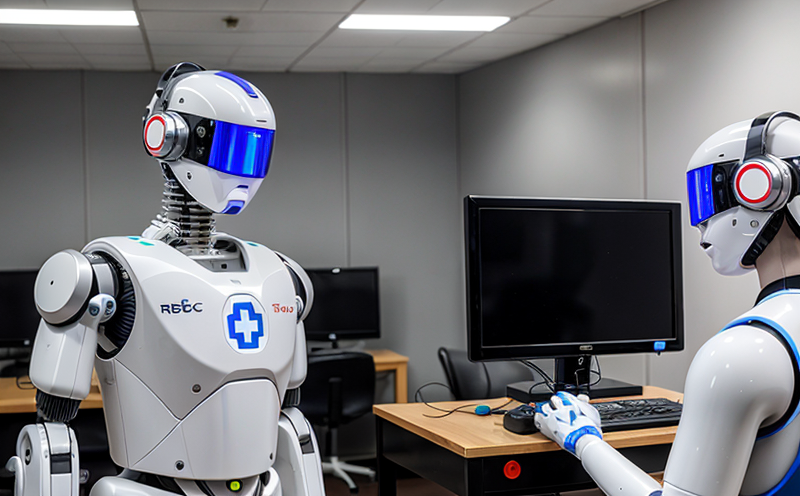ASTM F3217 Human Interaction Usability Testing for Service Robots
The ASTM F3217 standard is a critical framework for ensuring that service robots are designed, built, and deployed in ways that prioritize human safety, comfort, and usability. This standard focuses on the interaction between humans and service robots, covering aspects such as force, motion, and environmental factors to ensure safe and effective operation. Compliance with ASTM F3217 is essential for manufacturers looking to meet industry standards and regulatory requirements.
Service robots are designed to assist in a variety of tasks, including healthcare, hospitality, and logistics. These robots interact closely with people in their daily routines, making the human-robot interaction (HRI) experience a crucial element in design considerations. ASTM F3217 provides guidelines on how to assess these interactions, ensuring that they are safe, efficient, and user-friendly.
The standard emphasizes the importance of understanding the dynamics involved during HRI. It outlines specific parameters such as force thresholds, speed limits, and proximity alerts. These factors are critical in preventing accidents and ensuring that the robot does not cause discomfort or injury to the person it is interacting with. The ASTM F3217 protocol also considers the psychological impact on users by evaluating how the robot's design affects user trust and satisfaction.
The testing process involves several steps, including initial risk assessment, detailed specification of test scenarios, and implementation of safety protocols. Specimens for this type of testing are typically mock-ups or prototypes of service robots used in real-world applications. The specimens undergo rigorous testing to simulate various interactions and environmental conditions.
Instrumentation plays a vital role in ASTM F3217 testing. Sensors and actuators are utilized to measure critical parameters such as force, speed, and proximity. These measurements help in evaluating the robot's performance against the specified criteria. The data collected during these tests is then analyzed to ensure compliance with the standard.
The report generated from this testing process provides detailed insights into the robot's capabilities and limitations. It highlights areas where improvements are necessary to enhance safety and usability. This information is invaluable for manufacturers as it guides future design iterations and ensures continuous improvement in product quality.
Compliance with ASTM F3217 not only enhances public trust but also opens up new market opportunities by ensuring that service robots meet global standards. It demonstrates a commitment to excellence, which can be a deciding factor when companies are selecting suppliers or partners for their projects.
Quality and Reliability Assurance
- Data Collection: Comprehensive data is collected during each ASTM F3217 test to ensure accurate evaluation of the robot's performance. This includes force, speed, proximity, and user feedback.
- Analytical Tools: Advanced analytical tools are used to process the collected data, providing insights into potential areas for improvement.
The testing process is designed to be thorough and detailed, ensuring that every aspect of human-robot interaction is thoroughly evaluated. This approach not only enhances reliability but also improves the overall quality of service robots.
Regular audits are conducted to verify ongoing compliance with ASTM F3217 standards. These audits involve retesting key parameters periodically to ensure consistency in performance over time. By maintaining high levels of quality and reliability, we ensure that our clients' products remain safe and effective for their intended use.
Customer Impact and Satisfaction
- User Trust: Ensuring compliance with ASTM F3217 builds user trust by demonstrating a commitment to safety and comfort. This can lead to increased customer satisfaction and loyalty.
- Satisfaction Surveys: Post-testing surveys are conducted to gather feedback on the usability of the tested robots, helping us continuously improve our testing methods and service offerings.
The impact of ASTM F3217 compliance extends beyond just safety; it also enhances customer satisfaction by ensuring that service robots function seamlessly within their operational environments. By addressing user needs proactively during the design phase, we help create products that are not only functional but also enjoyable to use.
Satisfied customers lead to positive recommendations and repeat business, which is crucial for the success of any company in the robotics industry. Our rigorous testing process ensures that our clients' products meet or exceed expectations, leading to higher customer satisfaction rates.
Environmental and Sustainability Contributions
The ASTM F3217 standard plays a significant role in promoting sustainability by focusing on the environmental impact of service robots. By ensuring that these robots are designed with safety in mind, we reduce the risk of accidents and injuries, thereby minimizing potential harm to the environment.
Additionally, the standard's emphasis on usability helps in reducing energy consumption and resource usage. Robots that are well-designed for human interaction tend to operate more efficiently, leading to lower power consumption and reduced waste generation. This aligns with broader environmental goals and contributes positively to sustainability efforts within the industry.





